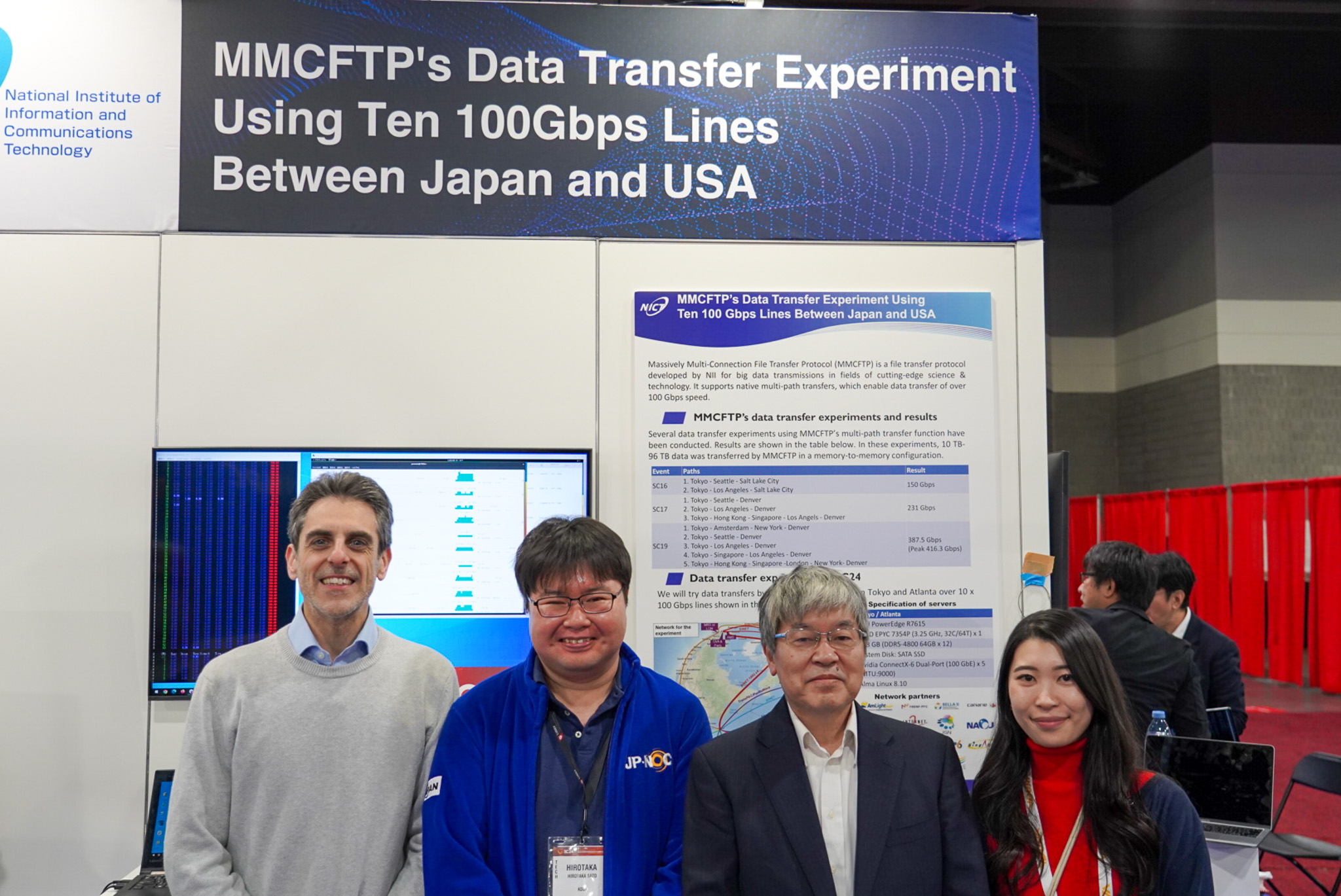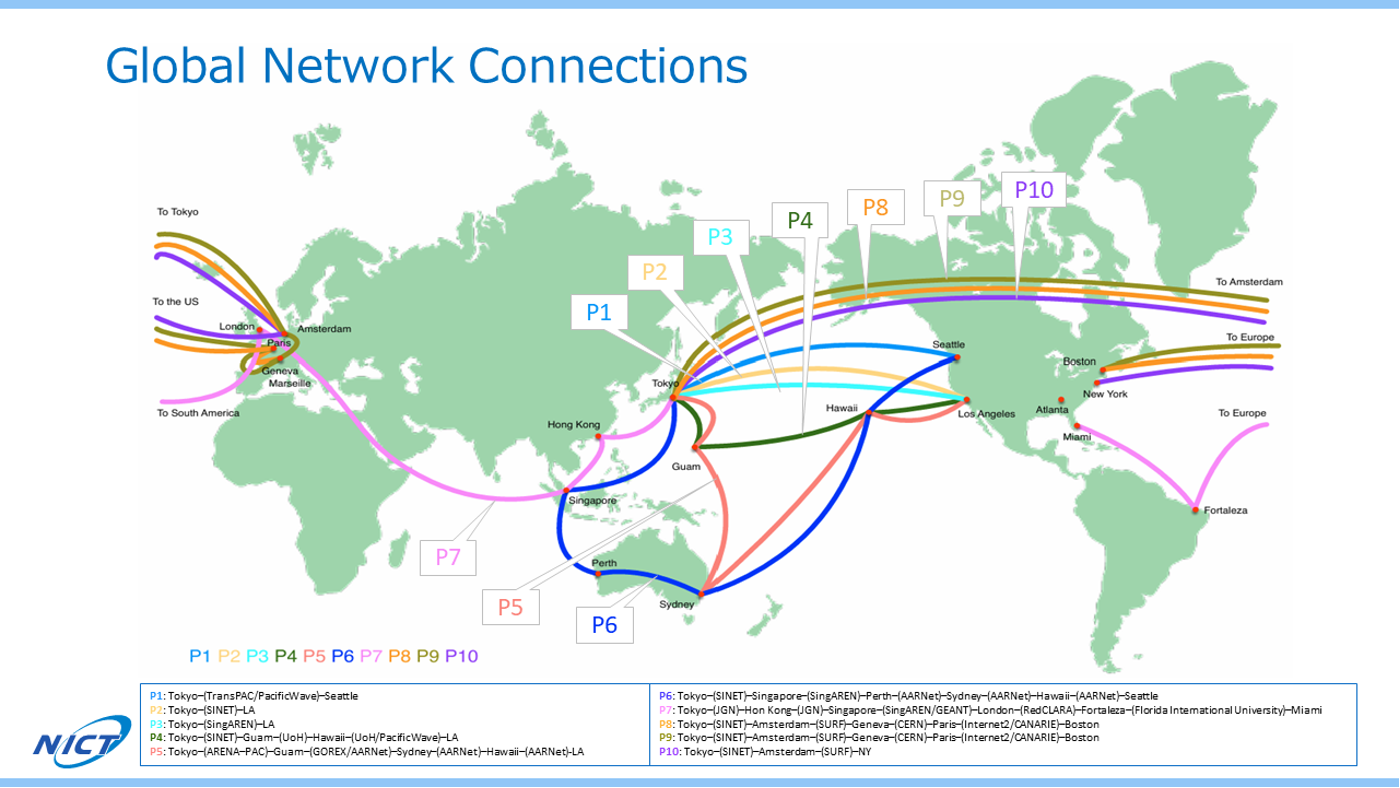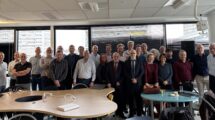Just as a living organism relies on interconnected systems to function, the global fabric of research and education depends on a web of networks, organisations, partnerships, collaborations and human interactions spanning the entire planet.
In November 2024, a groundbreaking experiment held at the Supercomputing Conference (SC24) in Atlanta clearly displayed the interconnectedness and combined strength of this global Research and Education Networking ecosystem worldwide.
A world-scale multi-path data transfer experiment
The ambitious experiment, held at SC24 and coordinated by NICT (National Institute of Information and Communications Technology), NII (National Institute of Informatics) and GÉANT, used the MMCFTP (Massively Multi-Connections file transfer protocol), developed by NII to transfer data between Japan and the US over ten different 100Gbps lines, simultaneously. The main aim was to prove the feasibility of high-speed multi-path transfers and promote the use of global data transfer in cutting-edge science and technology.

A global trust testbed
The experiment was made possible through an outstanding collaboration between Research and Education Networks, organisations and institutions all around the globe, led by NICT, NII and GÉANT and involving AARNet, AmLight-ExP, ARENA-PAC, BELLA II, CANARIE, CERN, Internet2, JGN, KAUST, NAOJ, NA-REX, Pacific Wave, RedCLARA, RNP, SCinet, SINET6, SingAREN, SURF, TransPAC, WIDE project, University of Hawaii.

Beyond technical achievements, the demonstration brought to the spotlight the importance and broad potential of global research and education networking collaboration, built on a shared foundation of trust, human connection, and shared commitment to advancing global science.
Keith Slater, Senior Service Manager at GÉANT: “Participating in the SC24 demonstration of MMCFTP, as the pan-European research and education network provider, was a true privilege: this project showcased the dedication of a global community to push the boundaries of data transfer capabilities.”
Akil Radhakrishnan, Senior Service Manager at GÉANT: “The demo links had to go through multiple entities, requiring a collaborative effort to plan the traffic engineering, establish common VLANs across domains, and handle configuration and testing. Successful collaboration depends on mutual trust, as it fosters a shared commitment to achieving a common goal. The fact that all entities involved in this setup worked together to support this demo speaks volumes about the unity and trust within our global R&E community.”
Hidehisa Nagano, Director General at ICT Testbed Research and Development Promotion Center of NICT: “In the SC24 exhibition, we constructed a world-scale 800 Gbps experimental network (10 x 100 Gbps route) which consists of JGN, NICT’s testbed network, and other global R&E networks. Several cutting-edge experiments and demonstrations were carried out on this valuable experimental environment. These would not have been possible without the cooperation of many organisations. We were also deeply impressed by the passion for R&D among all the organisations involved and the great power of collaboration. We would like to express our deepest gratitude to all the organisations that cooperated with us.”
Hirotaka Sato, Senior Network Engineer at NICT JGN Network Operation Center: “As a network engineer from NICT, I am deeply grateful for the countless helping hands we have received during our experiments and demonstrations from NRENs worldwide. Whether through partnerships or simply by stopping by, we are supported by many individuals and organisations. I am incredibly proud of what we have accomplished this year. Also, I am confident this community can achieve even greater things in future SC events.”
A stress test for the global fabric of R&E networking

As can sometimes happen in a cutting-edge testbed network like SCinet, unforeseen interoperability challenges arose during the initial setup. Yet, thanks to the work, patience, and dedication of the many network engineers on-site, the experiment ultimately succeeded, achieving peak results just short of the initial objective of 800 Gbps.
Nonetheless, the activity provided a valuable learning experience for all the organisations involved.
Resilience through collaboration
A critical factor in the success of the experiment was also the role of international and intercontinental agreements for mutual support and back-up among research and education networks, which ensure a strong resilience of the global R&E fabric. In particular, the back-up mechanism established under the Asia-Pacific Europe Ring (AER) collaboration was crucial to the feasibility of this demo (see the image below). Due to submarine cable cuts in the Red Sea, also affecting the original demo path on the GN5-IC1-procured Marseille-Singapore link (pink line), the demo traffic had to be re-routed onto the CAE-1 link between London and Singapore (orange line). To free up the required capacity over CAE-1, the back-up support from KAUST (green line) was fundamental to ensure regular service continuity beyond the demo between Asia and Europe.

Keith Slater, Senior Service Manager at GÉANT: “We coordinated closely with our international partners, solving challenges together. A heartfelt thank-you to our KAUST colleagues, who have consistently supported us throughout the year, as well as our AARNET and SingAREN partners for promptly agreeing to and facilitating the traffic adjustments.”
Read how the backup paths established via the Asia-Pacific Europe Ring (AER) collaboration supported re-routing of intercontinental connectivity throughout major disruptions in May 2024: https://aer-network.net/?p=131
Replicability and Impact
NII’s MMCFTP protocol utilised for the experiment holds great potential for high-speed, multi-path data transfers across intercontinental networks. Practical applications of this tool could be particularly suited for large global scientific collaborations requiring simultaneous data transfer, for instance in the areas of radioastronomy, earth observation, or climate modelling.
As MMCFTP can potentially generate very high-bandwidth traffic, its use is currently limited to data transfers through the Japanese SINET network (operated by NII), between SINET member institutions and their partners, including overseas organisations. Usage would also require prior agreement to the terms of use, and additional protective measures based on Quality of Service (QoS) functions to protect general traffic from MMCFTP traffic.
Ultimately, the demonstration highlighted the potential for transformative innovation brought about by the global collaboration of research and education networks worldwide and laid the ground for future network experiments. With plans to upgrade the SINET network’s Japan-US line to 400Gbps in April 2025, NII expressed their intentions to run another experiment at SC25, using a 400G Network Interface Controller to achieve even faster data transfer.
Terabit-scale anonymous communication leveraging programmable switches
A research team from Osaka University and Shimane University successfully ran a parallel experiment at SC24, based on the same global network configuration.
This experiment managed to demonstrate the possibility of terabit-scale anonymous communication using P4-based programmable switches, a major milestone in the development of large-scale anonymous communication infrastructure. During the demonstration, the team achieved an impressive 588.4 Gbps anonymous communication throughput and successfully streamed 4K video over this anonymous network.
Read more about the experiments conducted at the NICT booth at SC24 here: https://testbed.nict.go.jp/event_new/SC24.html







